I recently rediscovered a beautiful quote from Jonathan Ive on the fragility of ideas. This was part of the tribute he delivered at Steve Jobs’ 2011 memorial:
“Steve used to say to me — and he used to say this a lot — “Hey Jony, here’s a dopey idea. And sometimes they were. Really dopey. Sometimes they were truly dreadful. But sometimes they took the air from the room and they left us both completely silent. Bold, crazy, magnificent ideas. Or quiet simple ones, which in their subtlety, their detail, they were utterly profound.
“And just as Steve loved ideas, and loved making stuff, he treated the process of creativity with a rare and a wonderful reverence. You see, I think he better than anyone understood that while ideas ultimately can be so powerful, they begin as fragile, barely formed thoughts, so easily missed, so easily compromised, so easily just squished.”
It takes a special environment to nurture and incubate ideas at their most fragile, and to allow even the dopey ideas to get a hearing. Most organizations have more of a Darwinian approach to idea creation. But instead of survival of the “fittest”, the result is often survival of the “safest” ideas. And the safest ideas are rarely the most remarkable.
Organizations are often more adept at detecting risks than determining what ideas have the potential to be remarkable. It’s easier to critique than to create. I drew the following cartoon in 2007 to show how organizations are typically better equipped with cutting tools than growing tools.
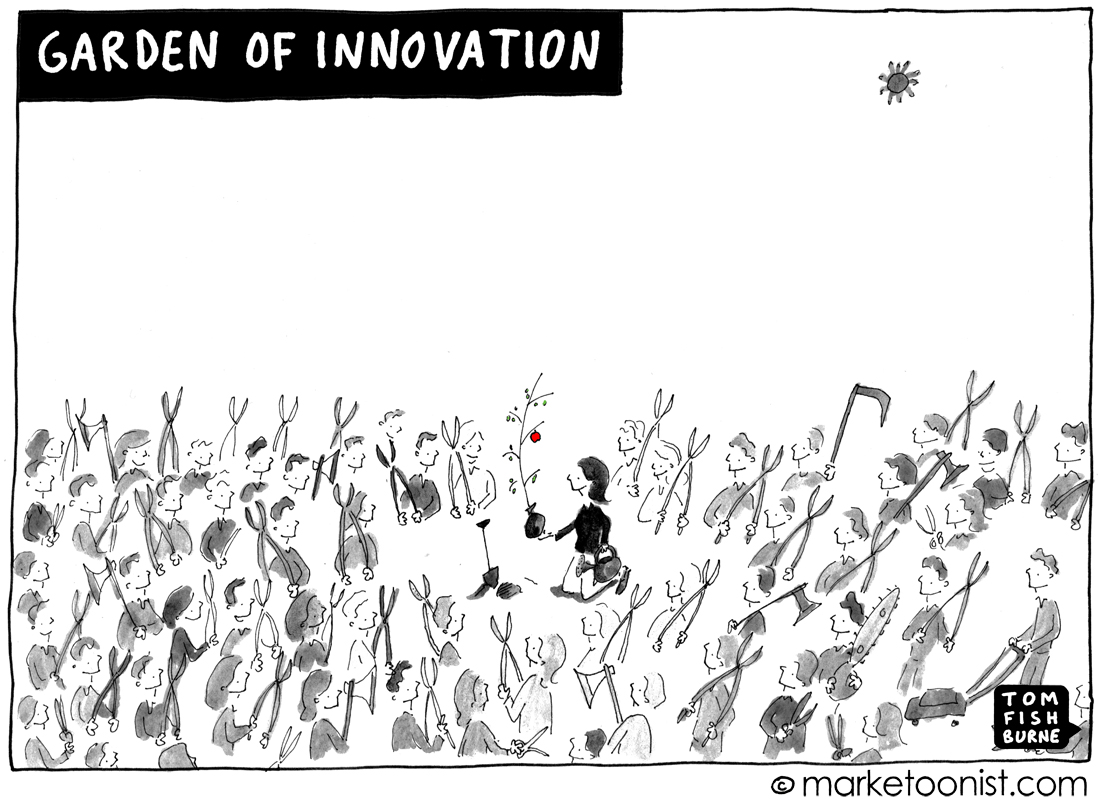
There’s plenty of time in innovation for the critical phase — the vetting, the sense-checking, the tire-kicking. But often we shortchange ideas at their most fragile.
Here are a few other related cartoons I’ve drawn over the years:
“Chief Idea Killer” February 2012
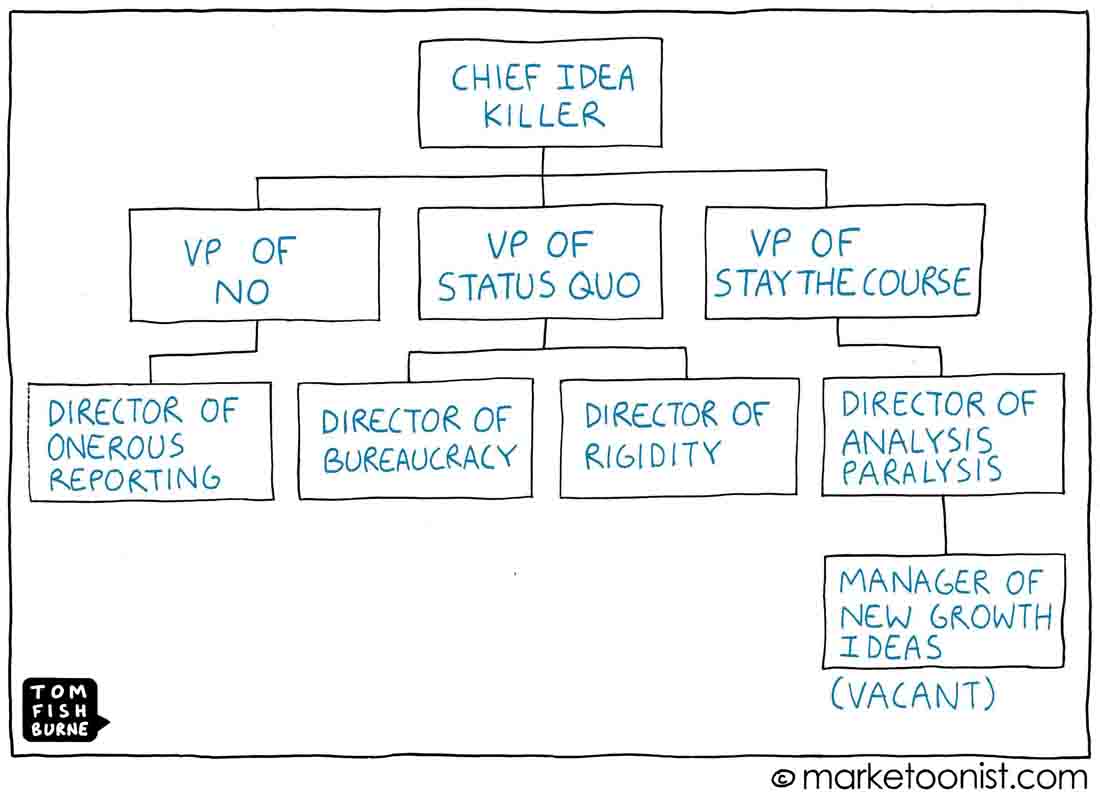
“Innovation Dreamers, Realists, and Spoilers” July 2018
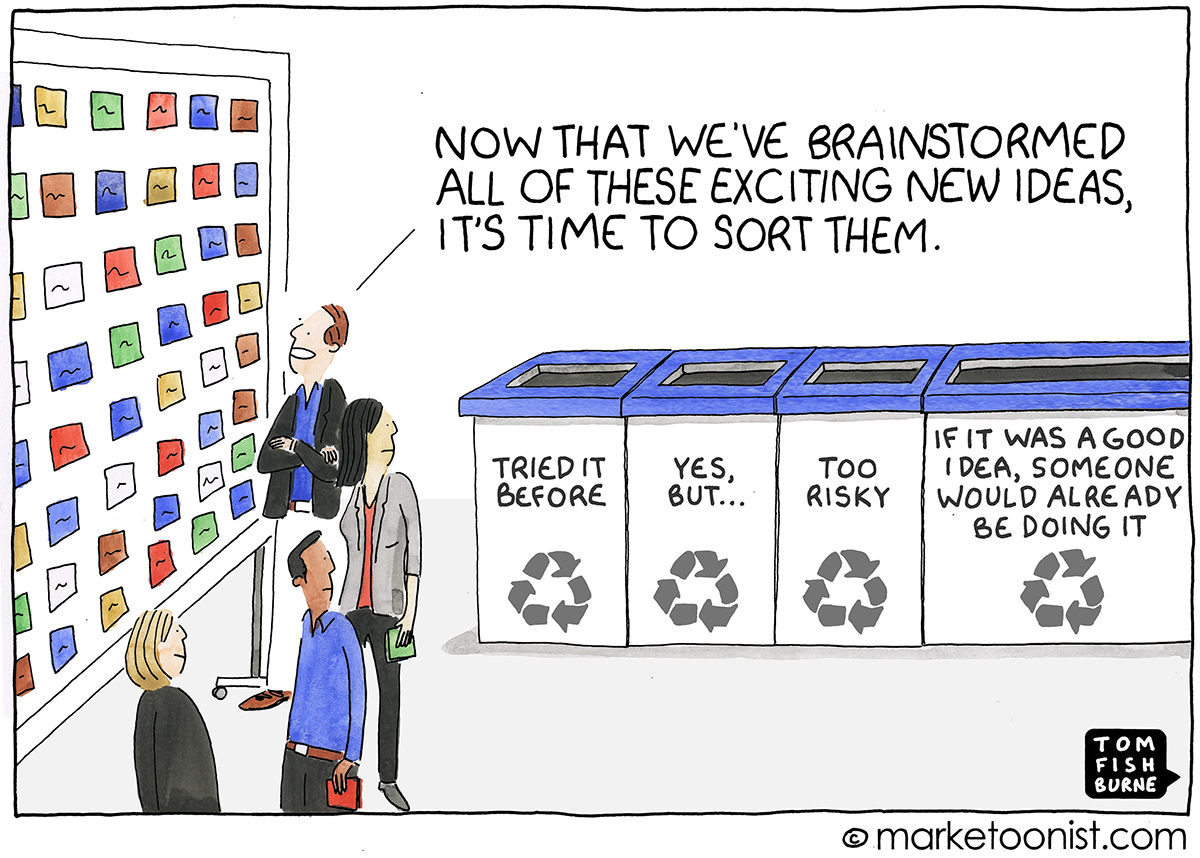
“Culture of Innovation” January 2018
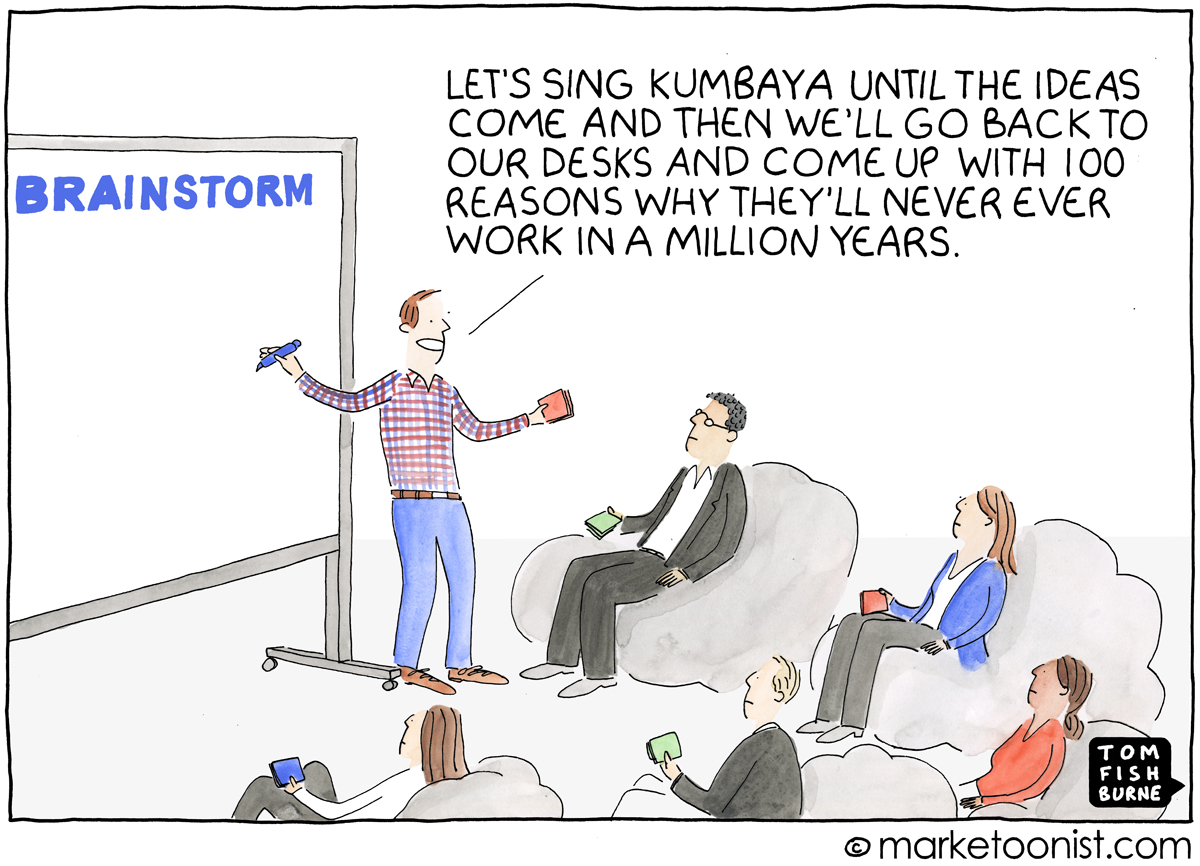
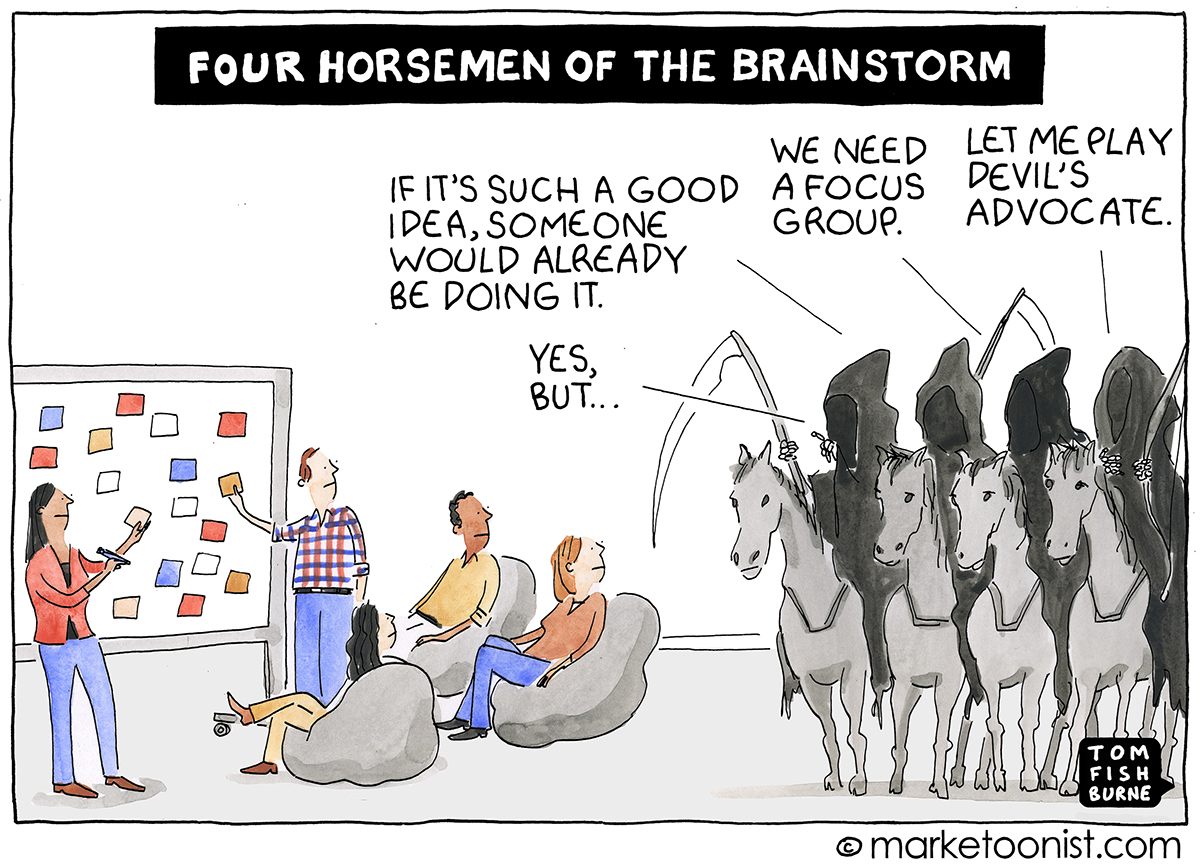
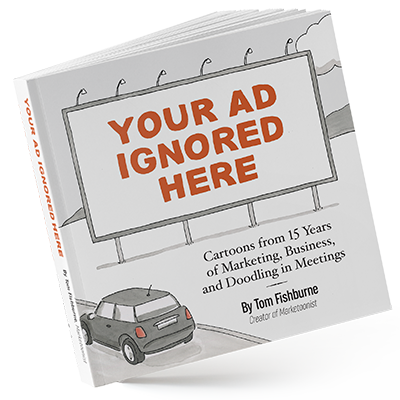

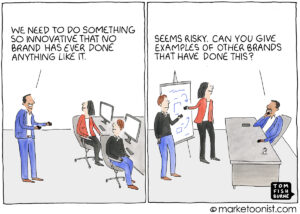
Judy Bernstein says
Yes and… the creators of brainstorming knew well and rigorously researched the 4 thinking guidelines that enable generating and nurturing “wild” ideas. Unfortunately, the term brainstorming has become mainstream but not the research validated guidelines that are essential to its success. Fortunately, the tools and methods of Creative Problem Solving and Human Centered Design, among other problem-solving systems, provide a structured approach to divergent and convergent thinking. These methods aren’t complicated and when utilized they act like Four Horsemen repellent.
Gary Dietz says
“Four Horsemen Repellent” – That’s a great product name.
Bill Mount says
Building on Judy Bernstein’s post, “Yeah, but…”
I spent several decades as a Real Live Certified Card Carrying Creative Guy (copywriter, ACD, creative director at several Brand Name Ad Agencies) before I ever even heard of Creative Problem Solving. At first I was skeptical because, after all, how dare anyone presume to systematize the magical, arcane conjurations my colleagues and I used to do our jobs?
But, once I learned more about it, I came to understand that CPS really can help a diverse range of people learn to do what “creative people” do instinctively. I didn’t even know that divergent and convergent thinking had names. It was just something we did in order to think stuff up.
But, once I dropped my defences (and even attended a weeklong Creative Problem Solving Institute Conference), I became, if not a disciple, then at least respectful of the concept.
I still have some pushback on a couple of the core tenets of CPS, though. Every time I hear, “Everyone is creative” and “There are no bad ideas”, I’m forced to blaspheme, “Yeah, but…”.
I believe some people can learn to be less uncreative, or less of an impediment to creativity, but that doesn’t mean that everyone is creative. Let’s be honest, there are a lot of people who should be kept on the other side of a lead wall from any kind of creative process.
As for “there are no bad ideas”, I have to append the ultimate waffle words, “up to a point.” Early in an ideation exercise, it’s fine to fill the room with as lots of random, flighty, goofy, unrestrained thinking. But, as quickly as possible, somebody is going to need to say stop, send most of the ideators away and get down to the job of making random, flighty, goofy, unrestrained ideas practical.
I’ve been part of way too many brainstorming sessions that went on and on, flooding the air with ever more impractical or just dumb ideas because nobody had the talent, confidence or authority to say, “That’ll do.”
If any fan of Marketoonist has never watched this ten-year-old video of IDEO developing designs for an innovative shopping cart, stop what you’re doing and watch it now. It’s a perfect depiction of “there are no bad ideas up to a point.” At about 5:20, you’ll see a small group of self-designated “adults” turn the brainstorming process “very autocratic” (their words) in a hurry.
https://www.youtube.com/watch?v=M66ZU2PCIcM
In all my exposure to Creative Problem Solving, I’m sure I’ve heard “there are no bad ideas” a few hundred times. But I never heard “Now somebody needs to decide – very quickly – which are the good ones.”
BC says
I’ve always felt there was no such thing as a “dopey” idea.
There will be ideas that some dismiss as dopey based on their experience and perspective (“we did that 5 years ago and it didn’t work”) but I think that last week’s dopey idea could be next week’s great one. The world keeps changing, so the context for ideas (and tools available to us) is different every day — some ideas may fit today better than yesterday.
That said, I also think that there is going to be a common set of similar ideas that come up in a brainstorming session. When a client is looking to answer the question “what do YOU think we should do?”, I take my first 10 ideas, write them down, seal them in an envelope and toss them in a drawer.
I feel like those first 10 ideas are *everybody’s* first 10 ideas (okay, not necessarily the same 10, but lots of overlap).
Doesn’t make them bad, but I like to flush them from the brain, challenge myself to look for new ones… So let’s start with number 11 and go from there.
And if that’s not fruitful, pull out the envelope and revisit those first 10 ideas. After considering other options, those 10 may look different to us as well.
In the end, there will be ideas which don’t fly — but even the experience (the process) of getting to that realization is another input into our “fund of knowledge” for the next time.
So please don’t kill dopey ideas — I don’t want to be even *more* limited in my contributions to the brainstorming process!
Ori Pomerantz says
Paradoxically, playing it safe is in the long run one of the most dangerous things you can do.
JC Andre says
I came across a great metaphor about new ideas a few years’ ago which went as follows: New ideas are like baby tigers, they are fragile and need all the protection and encouragement we can give them early on so they can grow strong and become powerful one day…
(I think there was even a consultancy based on the idea 😉